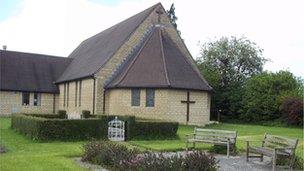Glastonbury Holy Thorn 'reborn' at Radstock college
- Published

The Holy Thorn on Wearyall Hill was a famous landmark in Glastonbury, Somerset
It is two years since residents in the Somerset town of Glastonbury woke to the news that their beloved Holy Thorn had been vandalised.
Overnight on 8 December, the tree - which is associated with the arrival of Christianity in Britain - was cut down.
A police investigation followed and news of the damage was reported around the world, particularly in the US.
The Holy Thorn grew from a cutting of a tree thought to have been planted by Joseph of Arimathea.
It is said to have sprung up when he planted his staff in the ground on Wearyall Hill more than 2,000 years ago.
It has been kept growing by grafting cuttings ever since.
'Powerful and symbolic'
The vandalism of the original tree, and also its subsequent replacement, prompted a college in Radstock to propagate cuttings from its own descendent of the tree.
In 2013, one of the saplings will be given to a church less than two kilometres (1.2 miles) from the college to mark the silver jubilee of the Holy Thorn's consecration.
The Reverend Rachma Bush, from St Peter's Church in Radstock, where the new tree will be planted, said she was "hopeful" the sapling would thrive.
"I think I and the people of St Peter's are excited by the possibility of the Holy Thorn sapling," she added.

St Peter’s Church in Radstock, Somerset, will receive the Holy Thorn sapling in 2013
"There is something very powerful and symbolic about the Holy Thorn which is both an old and rare tree and in our sapling will be a new, fragile growth needing care and nurture to thrive.
"We're hoping that it might be that the sapling is ready to come here on Mothering Sunday next year."
Mr Bush said he hoped the tree would "reach out to people" of all faiths and beliefs in the community.
The rare species of hawthorn has been growing at Norton Radstock College in Radstock for several years, and was itself propagated from the original thorn in Glastonbury.
Resurrection
"The thorn looked after by the college was donated years ago by a student," said Kevin Connell, senior curriculum leader for land based studies who is leading the project.
"We don't know of any others outside of Glastonbury and we have got a very healthy example.
"You never see it being propagated by nurseries or by horticulturists. This is a very unique opportunity for our students as well as helping to ensure an example of the Glastonbury Thorn is preserved."
Mr Connell will be working with Mr Bush and the church of St Peter's to make sure the sapling is looked after.
It is said the Holy Thorn flowers at Easter for the resurrection and at Christmas for the birth of Christ.
It's full name is Crataegus monogyna 'Biflora' which means it flowers twice a year - ordinary hawthorn, Crataegus monogyna, only flower in the spring.
There are several Holy Thorn trees dotted around Glastonbury.
As well as the one on Wearyall Hill, Glastonbury's medieval abbey also has a thorn, as does St John's Churchyard - a sprig from this one is sent to the Queen every Christmas.
- Published16 April 2012
- Published4 April 2012
- Published3 April 2012
- Published7 December 2011
- Published22 September 2011
- Published28 March 2011
- Published9 December 2010